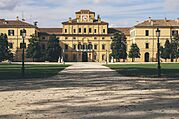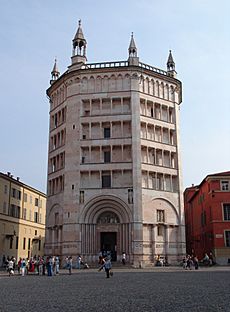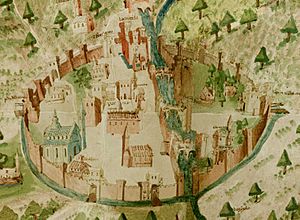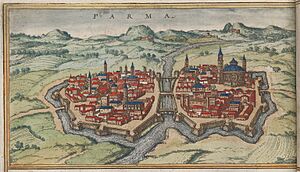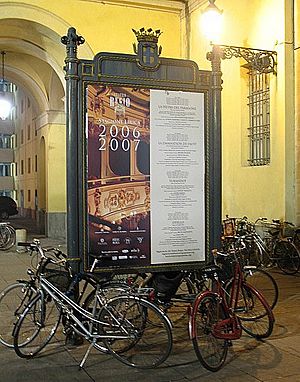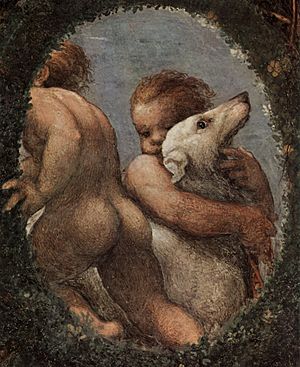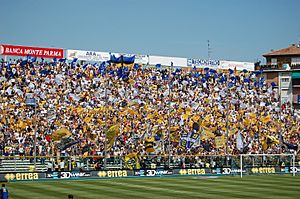Parma facts for kids
Quick facts for kids
Parma
Pärma (Emilian)
|
|||
|---|---|---|---|
| Comune di Parma | |||
|
From top left: Monument to Victory, Palazzo del Governatore, Parma Cathedral, Palazzo della Pilotta with Monumento al Partigiano, Palazzo del Giardino in Parco Ducale, Baptistery of Parma, aerial view from the Baptistery
|
|||
|
|||
| Country | Italy | ||
| Region | Emilia-Romagna | ||
| Province | Parma (PR) | ||
| Frazioni | See list | ||
| Area | |||
| • Total | 260.77 km2 (100.68 sq mi) | ||
| Elevation | 55 m (180 ft) | ||
| Population
(28 of October 2020)
|
|||
| • Total | 198,292 | ||
| • Density | 760.410/km2 (1,969.45/sq mi) | ||
| Demonym(s) | Parmesan, Parmigiano | ||
| Time zone | UTC+1 (CET) | ||
| • Summer (DST) | UTC+2 (CEST) | ||
| Postal code |
43121-43126
|
||
| Dialing code | 0521 | ||
| Patron saint | Sant'Ilario di Poitiers, Sant'Onorato, San Rocco | ||
| Saint day | January 13 | ||
Parma is a famous city in northern Italy. It's located in the Emilia-Romagna region. Parma is well-known for its beautiful buildings, amazing music, and delicious food. You might have heard of prosciutto (ham) and Parmigiano Reggiano cheese, which both come from here!
With almost 200,000 people, Parma is the second largest city in Emilia-Romagna. The University of Parma is also here, and it's one of the oldest universities in the world. A small river, also called the Parma, divides the city into two parts. The area on the west side of the river is known as Oltretorrente. The city's name comes from an ancient Etruscan word that the Romans used for a round shield.
Contents
Discovering Parma's Past
Early Beginnings
Parma has a very long history, going back to the Bronze Age. This was a time when people used bronze tools. Ancient villages called "terramare" were built here. These were wooden villages on piles, often near rivers. People also built their first burial grounds (necropolis) in Parma during this time.
Ancient Times
The Etruscans likely founded and named Parma. The name might have come from their word for a round shield, or because the city was shaped like one. It could also have been a "shield" against northern tribes.
The Romans created a colony here in 183 BC. Parma became an important stop on major Roman roads. It even had a forum, which is like a public square, where today you'll find Garibaldi Square. The city was destroyed in 43 BC but later rebuilt by Emperor Augustus. It was called Julia because it was loyal to the Roman emperors.
Later, in 452 AD, Attila attacked the city. It was also destroyed again during the Gothic War. For a while, it was part of the Byzantine Empire and was even called Chrysopolis, meaning "Golden City." From 569 AD, it became part of the Lombard Kingdom.
During the Middle Ages, Parma was a key stop on the Via Francigena. This was an important road for pilgrims traveling from Rome to Northern Europe. Many castles, hospitals, and inns were built to help these travelers. Parma also had a Jewish community, and its Palatine Library has one of the largest collections of Hebrew writings in the world.
Medieval Parma
Under Frankish rule, Parma became the capital of a county in 774. Like many cities in northern Italy, it was part of the Holy Roman Empire. However, local bishops often ruled it. Parma usually sided with the Empire in conflicts between the Pope and the Emperor.
Around 1140, Parma became an almost independent city-state, called a commune. After 1183, these communes gained more rights to govern themselves. Parma often had arguments with nearby cities over trade routes.
The city also saw struggles between the Guelphs and Ghibellines, two groups who supported either the Pope or the Emperor. In 1247–48, Emperor Frederick II attacked Parma, but his army was defeated in a big battle.
Later, Parma came under the control of Milan in 1341. Different powerful families, like the Sforza, Pallavicino, and Rossi, ruled parts of the area. These families built many towers and castles. Some of these family lands remained independent for a long time.
Modern History
In the 14th and 15th centuries, Parma was involved in the Italian Wars. The French controlled the city from 1500 to 1521. After that, it belonged to the Papal States until 1545.
In 1545, Pope Paul III gave Parma and Piacenza to his son, Pier Luigi Farnese. His family, the Farnese, ruled Parma until 1731. They improved the University and founded the Nobles' College. They also built a luxurious summer palace in Colorno.
In 1731, Don Carlos became Duke of Parma. But in 1734, he became King of Naples and Sicily, and his brother Philip took over Parma. Many of Parma's art collections were moved to Naples.
After 1748, Parma was influenced by France. The city became more modern, with new industries. Important places like the Biblioteca Palatina (Palatine Library), the Archaeological Museum, and the Botanical Garden were founded.
Recent Times
During the Napoleonic Wars (1802–1814), France took over Parma. It became the capital of the Taro Department. After Napoleon, the Duchy of Parma was restored in 1814.
In 1859, Parma joined the new province of Emilia. Then, in 1860, it became part of the unified Kingdom of Italy. Losing its role as a capital city caused some economic problems for Parma. However, it started to grow again with new railway connections.
Workers' unions were strong in Parma. In 1922, during the rise of Fascism, citizens fought back against the Fascist groups. This event is seen as an early example of resistance in Italy.
During World War II, Parma was a center for partisan resistance fighters. The train station was bombed by the Allies in 1944. Parts of the Palazzo della Pilotta, including the Teatro Farnese and part of the Biblioteca Palatina, were destroyed. Other important buildings were also damaged. Parma was freed from German occupation on April 26, 1945.
Parma's Location and Weather
Climate and Seasons
Parma has a climate with four distinct seasons. The average high temperature is about 17°C (63°F), and the average low is about 9°C (48°F). The city gets around 777 mm (30.6 inches) of rain each year. It also usually gets about 45 cm (18 inches) of snow every winter.
Parma is inland, so its climate is more "continental" than coastal areas. This means it has warmer summers and colder winters compared to places right by the sea.
| Climate data for Parma (1991–2020) | |||||||||||||
|---|---|---|---|---|---|---|---|---|---|---|---|---|---|
| Month | Jan | Feb | Mar | Apr | May | Jun | Jul | Aug | Sep | Oct | Nov | Dec | Year |
| Mean daily maximum °C (°F) | 6.8 (44.2) |
9.8 (49.6) |
15.4 (59.7) |
19.3 (66.7) |
24.4 (75.9) |
29.0 (84.2) |
31.6 (88.9) |
31.1 (88.0) |
25.4 (77.7) |
18.6 (65.5) |
11.9 (53.4) |
7.2 (45.0) |
19.2 (66.6) |
| Daily mean °C (°F) | 3.2 (37.8) |
5.1 (41.2) |
9.8 (49.6) |
13.9 (57.0) |
18.7 (65.7) |
23.0 (73.4) |
25.4 (77.7) |
25.1 (77.2) |
20.3 (68.5) |
14.4 (57.9) |
11.0 (51.8) |
5.1 (41.2) |
14.6 (58.3) |
| Mean daily minimum °C (°F) | −0.4 (31.3) |
0.5 (32.9) |
4.3 (39.7) |
8.5 (47.3) |
13.0 (55.4) |
17.0 (62.6) |
19.1 (66.4) |
19.0 (66.2) |
14.9 (58.8) |
10.5 (50.9) |
5.4 (41.7) |
0.7 (33.3) |
9.4 (48.9) |
| Average precipitation mm (inches) | 43.7 (1.72) |
50.2 (1.98) |
52.9 (2.08) |
80.1 (3.15) |
73.6 (2.90) |
61.0 (2.40) |
28.1 (1.11) |
51.1 (2.01) |
70.3 (2.77) |
104.1 (4.10) |
98.3 (3.87) |
60.5 (2.38) |
773.9 (30.47) |
| Source: Arpae Emilia-Romagna | |||||||||||||
Amazing Places to See
Religious Buildings
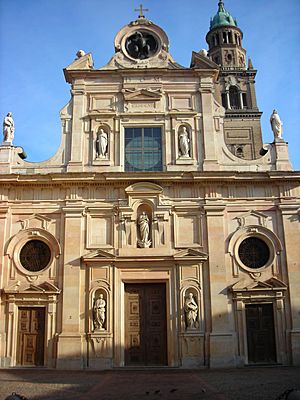
- Parma Cathedral: This is a Romanesque church with a sculpture from the 12th century by Benedetto Antelami. It also has a famous fresco by Antonio da Correggio.
- Baptistery: This unique building, started in 1196, stands next to the cathedral.
- San Giovanni Evangelista: An abbey church rebuilt in the late 1400s and early 1500s. It has a bell tower designed by Simone Moschino. The dome has an amazing fresco by Correggio.
- Sanctuary of Santa Maria della Steccata: Another important church in Parma.
- San Paolo: This former convent has frescoes by Correggio in the Camera di San Paolo.
- San Francesco del Prato: A Gothic church from the 13th century. It was used as a jail for many years!
- Santa Croce: A 12th-century Romanesque church that has been rebuilt several times.
- San Sepolcro: Built in 1275, this church has been renovated many times. Its Baroque bell tower was added in 1616.
- Santa Maria del Quartiere: This church, built between 1604 and 1619, has an unusual hexagonal shape.
Other Important Buildings
- Palazzo della Pilotta (1583): This large building houses many important places. It includes the Academy of Fine Arts, the Palatine Library, the National Gallery, the Archaeological Museum, and the Farnese Theatre.
- Palazzo del Giardino: Built in 1561 for Duke Ottavio Farnese. It's located in the Ducal Park, which was turned into a French-style garden.
- Palazzo del Comune: The city's municipal offices, built in 1627.
- Palazzo del Governatore ("Governor's Palace"): This building dates back to the 13th century.
- Bishop's Palace: Built in 1055.
- Ospedale Vecchio ("Old Hospital"): Created in 1250 and later updated.
People and Culture
Parma's Population
Parma is home to a diverse population. As of 2016, there were 192,836 people living in the city. About 16.46% of the population were under 18 years old, and 22.64% were 65 or older.
The city has seen a lot of growth in its population, especially with people moving from other countries. Many foreign-born residents come from countries like Moldova, Romania, Albania, and the Philippines.
| Parma | Italy | |
|---|---|---|
| 18 years old and under | 16.46% | 17.45% |
| 65 years old and over | 22.64% | 22.04% |
| Foreign Population | 15.91% | 8.29% |
| Births/1,000 people | 8.62 b | 8.01 b |
| Country of birth | Population |
|---|---|
| 4,967 | |
| 3,513 | |
| 2,661 | |
| 2,570 | |
| 1,561 | |
| 1,450 | |
| 1,292 | |
| 1,264 | |
| 1,104 | |
| 938 | |
| 819 |
Delicious Food and Cuisine
Parma is super famous for its food! It has a rich history of amazing dishes. Two of its most well-known specialties are Parmigiano Reggiano cheese and Prosciutto di Parma (Parma ham). These foods have a special status that protects their origin.
Parma also has many delicious stuffed pasta dishes. These include tortelli d'erbetta and anolini in brodo.
In 2004, Parma became the home of the European Food Safety Authority (EFSA). It was also named a UNESCO City of Gastronomy, which means it's recognized for its food culture. Big food companies like Barilla and Parmalat are based here too.
Famous People from Parma
Parma has been home to many talented people throughout history.
- Painters and Sculptors:
- Benedetto Antelami, a famous architect and sculptor.
- Antonio da Correggio, a well-known painter.
- Francesco Mazzola, also called Il Parmigianino, another famous painter.
- Other Notable People:
- Attilio Bertolucci, a poet.
- Bernardo Bertolucci, a famous director.
- Giambattista Bodoni, a typographer known for his typefaces.
- Elizabeth Farnese, who became Queen of Spain.
- Niccolò Paganini, a brilliant composer and musician.
- Arturo Toscanini, a world-renowned conductor.
- Giuseppe Verdi, one of the greatest opera composers of all time.
Sports in Parma
Parma is a city that loves sports!
- Football (Soccer):
- Parma Calcio 1913 is the city's main football club. They play in Serie A, Italy's top league. Their home stadium is the Stadio Ennio Tardini, which opened in 1923.
- Rugby:
- Zebre is a professional rugby team that competes in a top international league.
- Parma also has two other rugby teams in the national division: Overmach Rugby Parma and SKG Gran Rugby.
- American Football:
- The Parma Panthers is the city's American football team. They even inspired a book called Playing for Pizza by John Grisham.
- Other Sports:
- Pallavolo Parma is a volleyball team.
- Parma Baseball is the city's baseball team, playing at the Nino Cavalli Stadium.
Economy and Travel
Parma has a strong economy, especially in the food industry. Companies like Barilla, known for pasta, are based here. Chiesi Farmaceutici, a pharmaceutical company, also has its headquarters in Parma. The European Food Safety Authority is located in the city, too.
Getting Around Parma
- Train: Parma railway station is part of the main railway system connecting Milan and Bologna.
- Trolleybuses: Parma has a trolleybus system that has been running since 1953. It has four routes.
- Airport: Aeroporto Internazionale di Parma offers commercial flights to several European countries.
Sister Cities
Parma is connected with other cities around the world as "sister cities." This helps build friendships and cultural exchange.
 Bourg-en-Bresse, France
Bourg-en-Bresse, France Ljubljana, Slovenia
Ljubljana, Slovenia Shijiazhuang, China
Shijiazhuang, China Szeged, Hungary
Szeged, Hungary Tours, France
Tours, France Worms, Germany
Worms, Germany Stockton, United States
Stockton, United States
Images for kids
See also
 In Spanish: Parma para niños
In Spanish: Parma para niños






